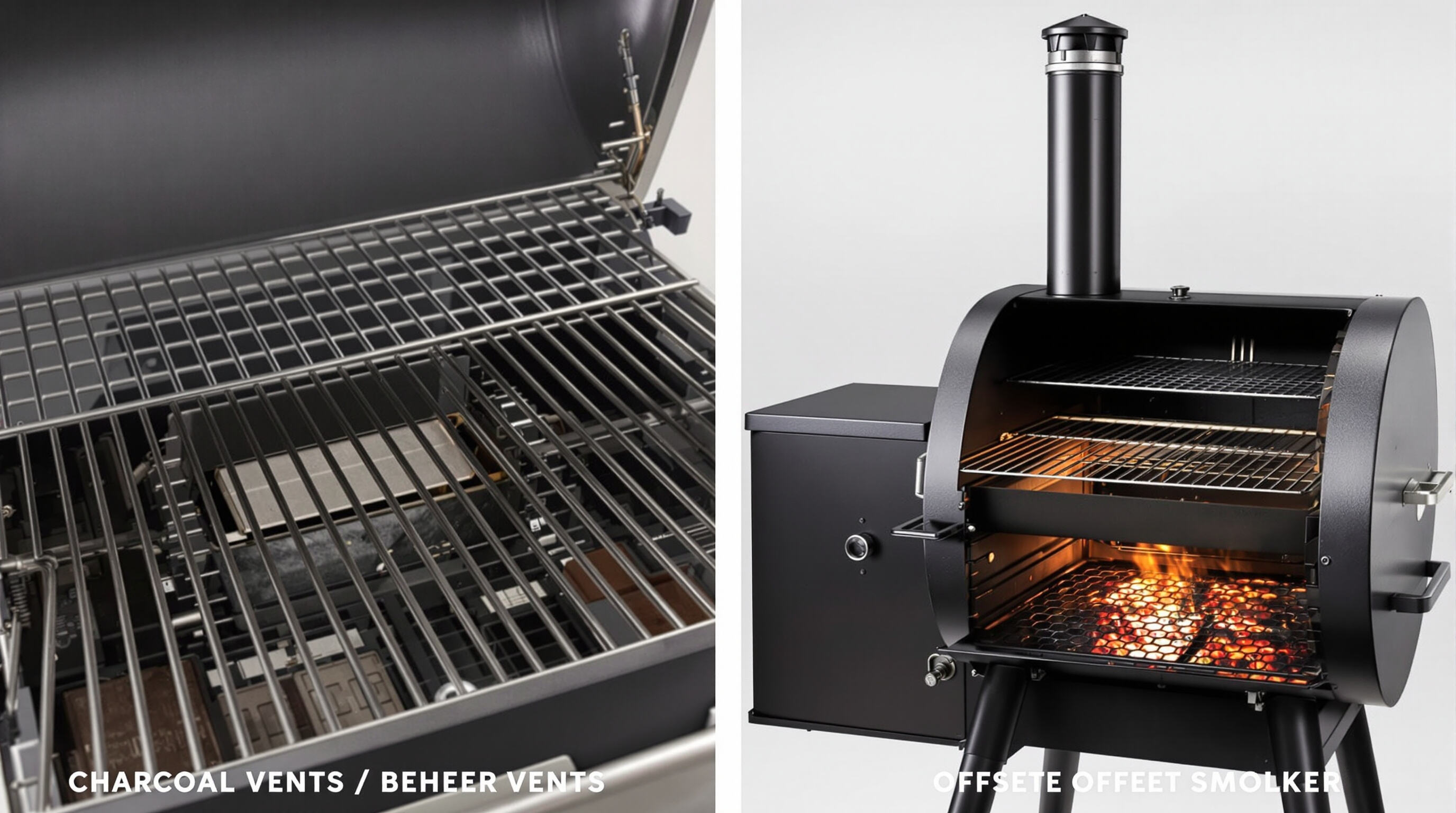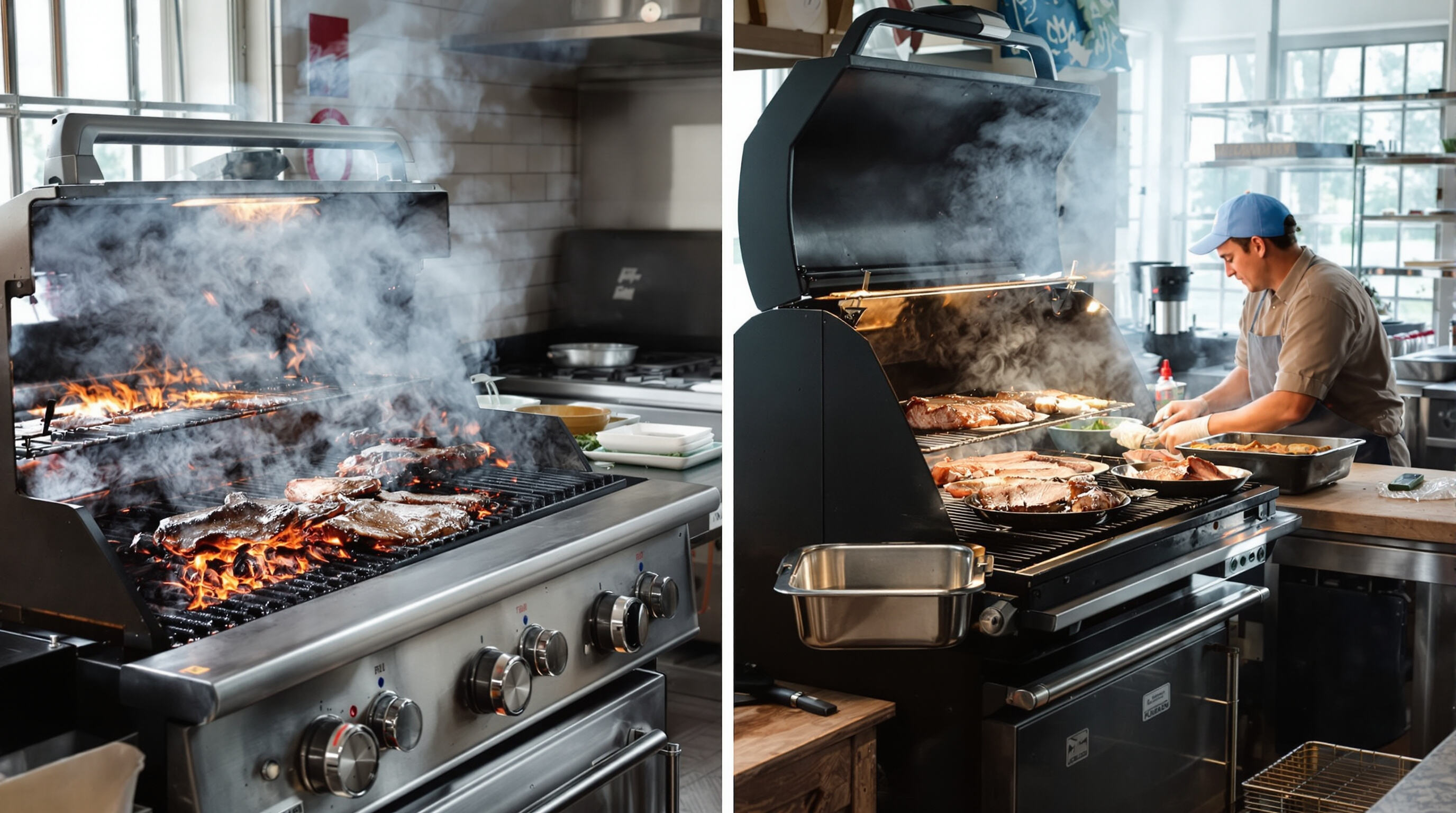Charcoal grills work by applying direct heat that gets things hot fast, usually over 500 degrees Fahrenheit. This makes them great for getting those nice crusty exteriors on steaks and burgers thanks to what's called the Maillard reaction. On the flip side, smokers take a different approach altogether. They spread out the heat indirectly, letting wood smoke mingle with meats at much cooler temps between about 195 and 275 degrees Fahrenheit over several hours. The survey numbers back this up pretty clearly too. According to recent data from outdoor cooking enthusiasts, around two thirds of experienced grillers turn to smokers when working with tougher cuts like brisket or ribs. Meanwhile, most folks grab their charcoal grills on busy weeknights when they need something ready quicker. Makes sense really.

| Feature | Charcoal Grill | Smoker |
|---|---|---|
| Heat Source | Directly below cooking grate | Separate firebox or chamber |
| Ventilation | Basic intake/exhaust vents | Precision dampers + chimney |
| Temperature Range | ±50°F fluctuations | ±15°F consistency |
Charcoal grills prioritize simplicity with a single cooking chamber and adjustable vents. Smokers separate the firebox from the cooking area, using tuned dampers to regulate airflow and smoke density—a design that reduces flare-ups by 92% compared to basic grills (2023 BBQ Tech Report).
Most charcoal grills are pretty easy to get going and work great for different types of cooking, usually ready to cook within about 15 to maybe 20 minutes or so. On the other hand, those offset smokers take a lot more attention when it comes to managing the fuel, but they can keep smoking food for over 12 hours with not much needed after startup. Business owners who need both fast results and good control over temperature have started looking at these new hybrid charcoal smoker grills that combine both features into one appliance. These units typically offer separate cooking zones which makes them really versatile for commercial operations where time matters but quality cant be compromised either.
Charcoal grills are great for those who love cooking over direct heat. They can get really hot, somewhere around 400 to maybe even 600 degrees Fahrenheit, which is perfect for getting that nice sear on steaks, burgers, and veggies. What happens here is something called the Maillard reaction, basically what makes food develop those beautiful browned crusts and deeper flavors. Sure, gas grills are convenient for sure, but there's just something about the way charcoal works. The intense heat from burning coals creates those classic sear marks nobody can resist, plus there's this amazing smoky flavor that comes through when juices hit the hot embers and start smoking away.
Smoking works best around 225 to maybe 250 degrees Fahrenheit, where indirect heat combined with real wood smoke slowly breaks down those tough connective tissues in cuts such as brisket or pork shoulder. This process takes anywhere from six up to eighteen hours depending on what's being cooked. Grilling throws food right into hot flames for just minutes at most, while smoking needs careful management of air flow and where exactly the fuel sits to keep things nice and low all day long. When hardwoods like hickory or applewood get burned, they give off these amazing smells that work their way into the meat over time. That creates that beautiful pink smoke ring we love so much plus makes the meat super tender something regular cooking methods just can't match when it comes to texture.
For quick weeknight dinners or those thinner cuts like chicken breasts and sausages that don't need much time on the heat, charcoal grills work great. They handle anything under 30 minutes pretty well too. When it comes to weekends, big parties, or those tougher cuts of meat that benefit from slow cooking, smokers are where it's at. Fatty meats especially love getting broken down in a smoker. And there's this awesome middle ground now with hybrid grills that combine both methods. Want to get a good sear on your steak first? Do it right over hot coals. Then shift it back to the cooler part of the grill with some wood chips going for that extra depth of flavor everyone loves so much these days.
Charcoal smoker grills create distinct flavor profiles shaped by their fuel sources and combustion methods. Understanding these differences helps chefs optimize smokiness, heat consistency, and aromatic complexity in grilled or smoked dishes.
When hardwood chips and chunks burn, they give off special chemicals called guaiacol and syringol that create those wonderful earthy and sweet flavors we love in smoked foods. Different woods bring their own character too. Mesquite brings some serious heat with its strong pepperiness, whereas apple or cherry woods tend to add just a hint of sweetness without overwhelming everything else. Most pitmasters know from experience that keeping wood moisture under about 20% works best. This allows just enough smoke to penetrate the meat's proteins while still letting the natural flavors shine through instead of getting lost in an overload of smokiness.
| Fuel Type | Avg. Burn Temp (°F) | Smoke Duration | Ideal Use Case |
|---|---|---|---|
| Lump Charcoal | 700–1,000 | 2–3 hours | High-heat searing |
| Hardwood Logs | 500–700 | 4–6 hours | Low-and-slow smoking |
| Charcoal provides intense, consistent heat with minimal smoke, while wood generates flavorful vapors but requires precise airflow control to avoid bitter creosote buildup. |
When grilling with hybrid setups, most folks start with charcoal as the main heat source and layer wood chunks on top to get that smoky flavor just right. The whole system keeps things at around 225 to 275 degrees Fahrenheit for several hours straight, which is great for slow cooking. Controlling how much smoke gets in there is possible by adjusting those little dampers in the firebox area. Many experienced cooks light all their charcoal first, then throw in some soaked hickory or oak chunks roughly every half hour or so. This method helps build up flavors gradually without making everything taste too smokey, something beginners often struggle with when trying out different woods.

Charcoal grills achieve 500°F+ in minutes, ideal for 10–15 minute searing of steaks or burgers. Smokers operate below 275°F (USDA 2023 smoking guidelines), requiring 4–16 hours to break down collagen in brisket or pork shoulder through low-temperature rendering.
| Cooking Method | Target Temp | Time Range | Primary Use Case |
|---|---|---|---|
| Grilling | 400–600°F | 5–30 min | Searing, quick-cook meats |
| Smoking | 200–275°F | 4–16+ hrs | Tough cuts, whole poultry |
Charcoal grills typically show 50°F temperature variance across grates, requiring frequent vent adjustments. Offset smokers maintain ±10°F precision through indirect airflow when using a two-zone setup: hot coals in the firebox, meat in the insulated chamber. Water pans add thermal mass to stabilize smoker temps.
Commercial kitchens often dedicate 3-hour blocks for smoking, synchronizing with vegetable prep and sauce simmering. A charcoal smoker grill hybrid setup allows transitioning between methods without equipment changes.
When deciding between a charcoal grill and smoker, most folks consider three main things: how experienced they are, what kind of food they want to cook, and how much room they have outside. Charcoal grills work great for getting that nice sear on steaks and burgers, plus they don't cost as much upfront. But let's be honest, keeping the temperature steady takes practice. Grill Mastery did some research and found around two thirds of people who try grilling for the first time struggle with this whole temperature thing. Smokers are different beasts altogether. They're perfect for those slow cooked meats like brisket or ribs where smoke penetration matters a lot. The offset smokers give cooks better control over smoke levels but come with a catch. These babies take up about 30 to 50 percent more space on the patio compared to smaller grills, so backyard size becomes a real consideration for many homeowners.
Businesses that need both flexibility and limited space often turn to hybrid charcoal smoker grills which combine direct grilling areas with separate smoking compartments. Many top brands are adding adjustable air vents and extra heating sections these days, making it easier to cook different types of meat at once during large gatherings. The 2024 report on grilling gear actually called this feature essential for food service professionals who cater big events. Vertical drum smokers are becoming popular too since they take up about 40 percent less floor space but still hold steady heat for over 18 hours according to what various industry folks have observed. When picking equipment, think about how it will be used most often. Quick burger flipping works best with regular charcoal setups, whereas those wanting slow cooked smoked dishes throughout the day should probably invest in proper smokers instead.
Charcoal grills apply direct heat for fast, high-temperature cooking, ideal for searing. In contrast, smokers utilize indirect heat with wood smoke at lower temperatures for slow cooking tough meats, enhancing flavor over time.
While primarily designed for grilling, charcoal grills can be adapted for smoking by using a two-zone setup and adding wood chunks for smoke, although maintaining a consistent low temperature might be challenging.
Hybrid charcoal smoker grills combine features of both grilling and smoking, offering separate zones for direct high-heat cooking and slower smoking, providing versatility for different cooking styles.